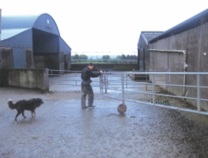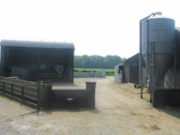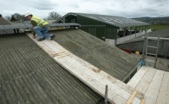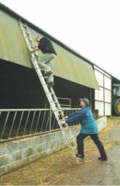Falls & Collapses
- Farmyards and buildings
- Building design
- Bale-stacking at heights
- Roof work
- Accessing heights
- Fall Collapse Fatalities
Farmyards and buildings
- Pay particular attention to farmyards and buildings because of the level of farm work in these areas and the high level of risk
- Assess the farmyard and buildings for hazards
- Make sure that the farmyard allows orderly movement of people, livestock and machinery
- Leave adequate space between buildings to allow easy turning and movement of machinery
- Identify blind spots or corners where an accident could occur, and put control measures in place
- Make sure that areas used for parking vehicles and mobile equipment are level, as rolling vehicles are a major cause of farmyard accidents
- Ensure a high level of tidiness and provide non-slip surfaces
|
 |
Building design
|
 |
Bale-stacking at heights
- Falling from stacks or loads of bales is the biggest cause of bale-handling injuries. This can be prevented by building secure stacks and binding stacks and loads
- Particular care is needed when removing bales from stacks, as many people, when trying to free jammed bales, fall from stacks or edges
- Remove big bales from the top first. Never remove bales from the bottom of the stack, as this may leave overhanging bales unsupported
In this video, Sean talks about the suffering and injuries he received when a bale of hay fell on him (4 minutes, 50 seconds).
Roof work
|
 |
In this video, agricultural contractor Stanley Scanlan remembers how he was seriously injured when he fell just 9 feet through a skylight.
Accessing heights
- Stairs should not have an excessive pitch or angle
- Each step should have an equal rise in height and width
- The sides of stairs should be protected by a wall or railing of sufficient strength
- Where a railing is used, there should be at least two rails, with the lower rail positioned mid-way between the top rail and pitch line
- To prevent falls, lofts, work platforms and walkways should have a protective barrier at the edge
- Over ground slurry tanks and grain or meal bins should have a secure working platform with protective rails and a safe means of access, such as a caged ladder
- Surfaces of stairs and walkways should be firmly fixed and should not become slippery while in use
- Sighting rails should be installed on silage-pit walls. The purpose of these is to indicate the location of the walls to the machine operator loading the silage when the silage is above the walls. They are not intended to prevent a machine overturning. In addition, sighting rails provide protection against a person falling
Ladders
|
 |
Scaffolds and platforms
- Extensive work at heights may require the use of scaffolds or properly designed work platforms
- Scaffolds should only be erected by people with appropriate training and experience
- Tower scaffolds can be useful but, because they are light and potentially unstable, need to be used with care. A free-standing tower used out of doors should not be higher than three times its base
Fall Fatalities
Falls from a height are the major cause of accidents involving farm buildings. Of particular concern is falling through fragile roofs and from ladders. Collapsing walls or earthen drains also cause deaths.
Fatal and serious accidents often happen when roofs are being quickly repaired. A total of 18% of all deaths in the agricultural sector are associated with falls or collapses. These deaths are particularly linked to fragile roof sheeting and skylights. Weathered skylights become indistinguishable from other roofing material. Both skylights and glass, when painted over, are not recognisable as such and are highly dangerous.
Deaths due to Falls 2014-2023 (13% of all fatalities)






